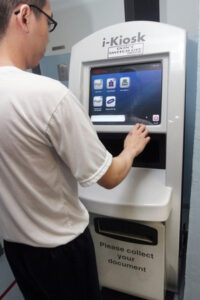 An article about the deployment of email and other electronic services via kiosks in prisons in Singapore. The problem with the use of kiosks is that you create the same access, prisoner movement, and queuing issues that currently exist with prison payphones. The meshDETECT secure prison cell phone is a much more efficient and cost effective means to deploy and deliver electronic content to detainees.
An article about the deployment of email and other electronic services via kiosks in prisons in Singapore. The problem with the use of kiosks is that you create the same access, prisoner movement, and queuing issues that currently exist with prison payphones. The meshDETECT secure prison cell phone is a much more efficient and cost effective means to deploy and deliver electronic content to detainees.
Corresponding with family members electronically, instead of using pen and paper, could soon become a reality for prison inmates here.
Over the next few years, the prison authorities are exploring the option of allowing inmates to type out their letters, which will then be sent by the prison staff to the intended recipients via an electronic portal – as part of its plans to move with the times and tap on technology to enhance the rehabilitation process for the inmates.
Singapore Prison Service Senior Assistant Director (Technology) Kuai Ser Leng said: “I tell the staff … I don’t even write letters anymore – when is the last time you wrote letters with pen and paper?
“Almost consistently, they tell me the same answer (that) they can’t remember the last time they wrote a letter. We email, we use SMS, we use Whatsapp these days.”
Apart from allowing inmates to go paperless while corresponding with the world outside, the prison authorities are also exploring ideas such as giving the inmates access to e-books and e-learning opportunities.
Currently, family members of inmates can book visits online. One project that has already been successfully piloted is the use of self-service kiosks, via which prisoners can submit their requests such as longer visiting time and a change in diet. Previously, inmates convey their requests verbally to their prison supervisors.
The inmates can also use the kiosks to track the status of their requests or check the availability of new courses.
To build rapport between prison officers and the inmates, a mobile device is also available for the officers to, for instance, access instantly the bio-data of an inmate instead of having to check it on the computer in the office.
On the device, Senior Prison Officer Roy Phang said: “It allows us to find out more about the inmates immediately as they could be new admissions. We are also able to key in observations at the point where we observe certain behavioural changes in the inmates.”
Mr Kuai told TODAY that there are plans to increase the features of the self-service kiosks, including allowing inmates to check on their privileges.
The prison authorities saw the use of the kiosks as an opportunity for inmates to familiarise themselves with technology – which would also help them assimilate back into society upon their release.
Singapore After-Care Association Director Prem Kumar welcomed the adoption of technology in the prisons.
Not only does it increase efficiency, it also empowers the inmates, Mr Kumar said. “As long there is an effort to outreach and empower those who are not tech savvy, that will be ideal.”
The prison authorities are also tapping on technology to improve the security of the premises.
Currently, there are thousands of surveillance cameras installed at Changi Prison Complex. The authorities are studying the use of video content analysis to detect abnormal behaviour exhibited by the inmates by incorporating video intelligence into the existing surveillance system.
They are also looking to use audio analytics to act as ears on the ground to detect aggressive voices. This could provide early warning to the staff for appropriate intervention.
- Multi-Blockchain System for Inmate Forensics - April 2, 2024
- Blockchain to Secure Attorney-Inmate Privacy for Prison Calls - June 28, 2023
- meshDETECT® Announces Grant of Ninth Patent For Blockchain Wireless Services - August 26, 2022




